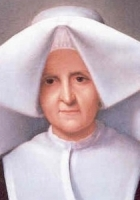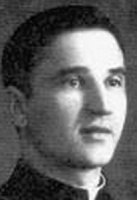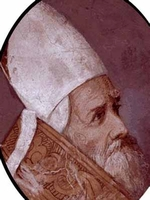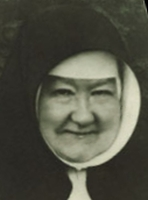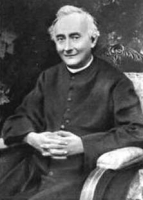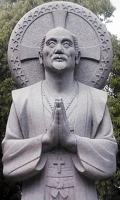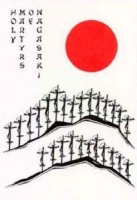Pope Blessed Pius IX
அருளாளர் ஒன்பதாம் பயஸ்
255வது திருத்தந்தை:
பிறப்பு: மே 13, 1792
செனிகல்லியா, மார்ச்சே, திருத்தந்தை நாடுகள்
இறப்பு: பெப்ரவரி 7, 1878 (வயது 85)
திருத்தூதரக அரண்மனை, ரோம் நகரம், இத்தாலி
ஏற்கும் சமயம்:
ரோமன் கத்தோலிக்க திருச்சபை
முக்திப்பேறு பட்டம்: செப்டம்பர் 3, 2000
திருத்தந்தை இரண்டாம் ஜான் பால்
"ஜியோவன்னி மரிய மஸ்டாய் ஃபெர்ரெட்டி" (Giovanni Maria Mastai Ferretti) எனும் இயற்பெயர் கொண்ட அருளாளர் ஒன்பதாம் பயஸ், கத்தோலிக்க திருச்சபையின் 255வது திருத்தந்தையாக கி.பி. 1846ம் ஆண்டு, ஜூன் மாதம், 16ம் நாள் முதல், 1878ல் தமது மரணம்வரை ஆட்சி புரிந்தவர் ஆவார்.
கி.பி. 1792ம் ஆண்டும், மே மாதம், 13ம் நாள், “செனிகல்லியா” (Senigallia) என்னுமிடத்தில், "கிரோலமோ டேய் கொண்டி ஃபெர்ரெட்டி" (Girolamo dei conti Ferretti) எனப்படும் பிரபுக்கள் குடும்பத்தில் ஒன்பதாவது குழந்தையாகப் பிறந்த இவர், பிறந்த அன்றே திருமுழுக்கும் பெற்றார். "வோல்டேர்ரா" மற்றும் ரோம் (Volterra and in Rome) நகரிலுள்ள "பியாரிஸ்ட்" (Piarist College) கல்லூரியில் கல்வி கற்றார். தமது சொந்த ஊரான 'செனிகல்லியாவில்' (Senigallia) இறையியல் கற்ற இவர், கி.பி. 1814ம் ஆண்டு, ஃபிரெஞ்ச் சிறையிருப்பிலிருந்து (French captivity) திரும்பியிருந்த திருத்தந்தை ஏழாம் பயசை (Pope Pius VII) சந்தித்தார். கி.பி. 1815ம் ஆண்டு, திருத்தந்தையின் உயர் காவலராக இணைந்த இவர், திடீரென தமக்கு ஏற்பட்ட வலிப்பு நோய் காரணமாக வி்ரைவிலேயே அதிலிருந்து நீக்கப்பட்டார். திருத்தந்தையின் கால்களில் தஞ்சமடைந்த இவரை எழுப்பிய திருத்தந்தை இவர் இறையியல் படிப்பைத் தொடர ஆதரவு தந்தார்.
கி.பி. 1819ம் ஆண்டு, ஏப்ரல் மாதம், 10ம் தேதி, இவர் குருத்துவம் பெற்றார்.
கி.பி. 1827ம் ஆண்டு, தமது 35 வயதில் மஸ்டாய் திருத்தந்தை பன்னிரெண்டாம் லியோவால் (Pope Leo XII) "ஸ்போலேட்டோ" (Spoleto) உயர் மறைமாவட்டத்தின் பேராயராக நியமிக்கப்பட்டார். கி.பி. 1840ம் ஆண்டு, "புனித மர்செல்லினோ ஈ பியெட்ரோவின்" கர்தினால் குருவாக (Cardinal-Priest of Santi Marcellino e Pietro) அறிவிக்கப்பட்டார்.
கி.பி. 1846ம் ஆண்டு, திருத்தந்தை பதினாறாம் கிரகோரியின் (Pope Gregory XVI ) மரணத்தின் பின்னர் நடந்த திருத்தந்தை தேர்தலில் மஸ்டாய் தேர்ந்தெடுக்கப்பட்டு, திருத்தந்தையாக அருட்பொழிவு செய்யப்பட்டார். தமது பெயரையும் ஒன்பதாம் பயஸ் (Pius IX) என்று ஏற்றுக்கொண்டார்.
32 ஆண்டுகள் திருத்தந்தையாக இருந்த இவரே அதிக காலம் இப்பதவியினை வகித்தவ திருத்தந்தை ஆவார். இவர் கூட்டிய “முதல் வத்திக்கான் பொதுச்சங்கம்” (The First Vatican Council) (கி.பி. 1869-1870) திருத்தந்தையின் தவறா வரம் ஒரு விசுவாசக் கோட்பாடு என அறிக்கையிட்டது.
தூய கன்னி மரியாளின் அமலோற்பவத்தை இவர் ஆதரித்தார். மரியாளுக்கு இடைவிடா சகாய மாதா என்னும் பட்டத்தையும் அளித்தார். இப்பட்டத்துக்கு காரணமான கிரீட் தீவு பைசாந்திய ஓவியத்தை உலக இரட்சகர் சபை குருக்களின் பாதுகாவலில் ஒப்படைத்தார்.
திருத்தந்தை நாடுகளின் அரசராக இருந்த இறுதி திருத்தந்தை இவர் ஆவார். 1870ம் ஆண்டு, அது இத்தாலிய தேசியவாத படையினரால் கைப்பற்றப்பட்டு இத்தாலிய பேரரசுடன் இணைக்கப்பட்டது.
இவருக்கு முக்திபேறு பட்டம் வழங்குவதற்கான நடைமுறைகளின் ஆரம்ப கட்டத்திலே, அதனை இத்தாலிய அரசு தீவிரமாக எதிர்த்தது. அவருடைய சர்வாதிகாரமான மற்றும் பிற்போக்குத்தனமான அரசியலை காரணம் காட்டி, சில யூதர்களும் கிறிஸ்தவர்களும் விமர்சித்ததால், அவரது முக்திபேறு பட்டம் சர்ச்சைக்குரியதாகவே இருந்தது. திருத்தந்தை “இரண்டாம் ஜான் பவுல்” (Pope John Paul II) கி.பி. 1985ம் ஆண்டு, ஜூலை மாதம், ஆறாம் நாளன்று, இவரை வணக்கத்திற்குரியவர் என அறிவித்தார்.
கி.பி. 2000ம் ஆண்டு, செப்டம்பர் மாதம், மூன்றாம் தேதி, திருத்தந்தை “இருபத்திமூன்றாம் யோவானோடு” (Pope John XXIII) இவருக்கும் அருளாளர் பட்டம் அளிக்கப்பட்டது.
இவரது நினைவுத் திருவிழா நாள் ஃபெப்ரவரி 7 ஆகும்
Also known as
Giovanni Maria Mastai-Ferretti
Profile
Son of Gerolamo Ferretti and Caterina Solazzi, local nobles, the family's ninth child. Frail, intelligent and pious boy who suffered from epilepsy when young. Educated at the Piarist College, Volterra, Italy from 1802 to 1809. Studied in Rome from 1809 to 1810 due to political disturbances in the city. He returned in 1814 and asked for admission to the Papal Noble Guard, but was turned down due to his epilepsy. Studied theology at the Roman Seminary from 1814 to 1818, during which his epilepsy disappeared. Ordained on 10 April 1819 in Rome. Spiritual director of the orphan asylum of Tata Giovanni, Rome. Auditor of the apostolic delegation to Chile from 1823 to 1825. Canon of San Maria in Via Lata, Rome. Director of San Michele hospital in Rome. Chosen archbishop of Spoleto, Italy on 21 May 1827. Named assistant at the Pontifical Throne on 1 June 1827. Archbishop of Imola, Italy on 17 December 1832. Created cardinal on 23 December 1839 by Pope Gregory XVI. Chosen 255th pope in the conclave of 1846.
Last pope to hold temporal power, that is, to rule a secular state. His election raised the hopes of patriotic and liberal circles of Catholics. One of his first acts was an amnesty for all political prisoners. Defined the dogma of the Immaculate Conception of the Blessed Virgin Mary on 8 December 1854. Celebrated the First Vatican Council from 1869 to 1870, which was interrupted by the Franco-Prussian War. This council defined the dogma of papal infallibility. He supported several reforms in the Papal States, which included central Italy, and several outlying areas, such as Assisi, but lost the territory due to the unification of the Kingdom of Italy in 1870 and 1871. Created 123 cardinals. Gained a reputation for being a patriotic, and reforming Pope, and only Saint Peter the Apostle served longer.
Pius IX's cause for beatification was one of the longest and most difficult in Church history. Begun under Pius X on 11 February 1907, re-launched by Benedict XV without much success, later by Pius XI, and then by Pius XII on 7 December 1954. The decree on the heroic exercise of theological and cardinal virtues was finally promulgated by the Congregation for the Causes of Saints on 6 July 1985, allowing his proclamation as Venerable. Among Pius IX's most outstanding virtues were his unconditional love for the Church, his charity, and his high regard for the priesthood and for missionaries.
Born
13 May 1792 in Senigallia, Italy as Giovanni Maria Mastai Ferretti
Papal Ascension
• elected on 16 June 1846
• installed on 21 June 1846
Died
• 7 February 1878 in Vatican City of natural causes
• buried in the basilica of San Lorenzo fuori le mura, Rome, Italy
Beatified
3 September 2000 by Pope John Paul II at Saint Peter's Square, Rome, Italy
• the beatification miracle was the inexplicable healing of a French nun
Blessed Rosalie Rendu
Also known as
Jeanne Marie Rendu
Profile
Eldest of four daughters in a middle class mountain family. When she was three years old, the French Revolution broke out. Priests loyal to Rome were expelled, killed, or chased into hiding. Jeanne's family hid those who stayed to minister to French Catholics, claiming that they were hired farm hands; the girl made her First Communion in her basement at a Mass celebrated by one of these covert priests. Her father died on 12 May 1796 when Jean Marie was nine years old, and her baby sister a few months later. She was educated for two years at an Ursuline boarding school in Gex, France.
As a young girl, Jean Marie began working with the Daughters of Charity at the local hospital. On 25 May 1802, at age 16, she entered the congregation at the motherhouse of the Daughters of Charity in Paris, France, taking the name Rosalie. The intensity of her new devotional life harmed her health, and she was transferred to the house in the Mouffetard District, one of the poorest in 19th century Paris; she worked in the slum for 54 years. She worked with the sick and poor, taught catechism, and taught girls to read. Superior of her community in 1815. She started a free clinic, pharmacy, school, orphanage, child-care center, youth club for young workers, and a home for the elderly poor. Awarded the Cross of the Legion of Honour by Napoleon III in 1852 for her charitable work; she wanted to refuse, as she sought no personal honour, but was ordered by her superiors to accept it. Blind during the last two years of her life.
Born
9 September 1786 at Confort, Gex, France as Jeanne Marie Rendu
Died
7 February 1856 at Paris, France of natural causes
Beatified
9 November 2003 by Pope John Paul II
Saint Giles Mary-of-Saint-Joseph
Also known as
• Aegidius Mary of Saint Joseph Pontillo
• Egidio Maria da Taranto
• Egidio Maria de Saint Giuseppe
• Egidio Maria of Saint Joseph
• Francesco Postillo
• Francis Pontillo
• Idzi Maria od sw Józefa
• Saint of the Little Way
Profile
Born to a pious family and raised in a small village. When his father died in 1747, Francesco took up the trade of rope maker to support his mother and siblings. Drawn to a religious life, he applied to the Discalced Friars Minor of Saint Peter of Alcantara at Naples, Italy in 1754 at age 25. He wished to become a priest, but lacked the education, and was received as a lay brother.
Porter and gate-keeper at his monastery's seminary, a position that put him in constant contact with those in need. He had a special ministry to the sick, and worked with lepers, travelling outside the city to help those who had become shunned and isolated; he often carried an icon of the Blessed Virgin Mary in a depiction known as Our Lady of the Well when he made sick calls. Giles himself suffered from sciatica, which caused severe leg pain, difficulty walking and led to the use of a cane which is often seen in depictions of him; he also suffered from asthma and, late in life, dropsy (fluid retention leading to high blood pressure). Even in life he was considered by locals as a saint and patron of the sick and outcast. Legend says that when he was charged with distributing food and alms to the poor, Saint Joseph would intervene to insure he never ran out.
Born
16 November 1729 at Taranto, Apulia, Italy as Francis Pontillo
Died
• 7 February 1812 at Naples, Italy of natural causes while at prayer
• huge crowds turned out for his funeral
• his relics are enshrined in an urn next to the icon of Our Lady of the Well in the church of San Pasquale Baylón in Taranto
Canonized
• 2 June 1996 by Pope John Paul II
• his canonization miracle involved the cure of Mrs Angela Mignogna in 1937
Patronage
Taranto, Italy (chosen on 29 June 1919 by Archbishop Orazio Mazzella of Taranto
Representation
• Franciscan friar with a cane
• Franciscan friar with a picture of Our Lady of the Well
Saint Theodore Stratelates
Also known as
• Theodore the General
• Theodore Tyro
• Theodore the Recruit
• Theodore Tiro
• Theodor Tiro of Euchaïta
• Theodore of Amasea
• Theodore Teron
• Theodorus of Heraclea
Additional Memorials
• 16 February as Theodore Tyro
• 17 February on the Orthodox Calendar
• 27 July on Korcula, Greece
• 9 November as Theodor Tiro of Euchaïta
Profile
Roman general (stratelates) and covert Christian during a time of persecution. Exposed as a Christian, a military tribunal decided he was a good soldier who had made a mistake, told him to reconsider, and set him free; he promptly burned down a pagan temple. Arrested again, he was ordered to apostatize, then tortured by having his flesh torn off; he responded by reciting the Psalms. Martyr.
Saint Theodore Tyro is almost certainly the same person as Theodore Statelates. The Tyro story describes the soldier as a recruit, the feast day is 9 November, and the region is slightly different, but the story is the same.
Died
martyred 319 at Heraclea, Thrace
Patronage
• recovery of lost articles
• soldiers
• Brindisi, Italy, city of
• Brindisi-Ostuni, Italy, archdiocese of
• Venice, Italy
Representation
• crocodile
• crown of thorns
• martyr's wreath
• palm
• pyre
• soldier
• spear
• temple
• torch
Blessed Anthony of Stroncone
Also known as
• Anthony Vici
• Antonio de Stronconio
Additional Memorial
9 February (Franciscans)
Profile
Raised in a pious family, both Anthony’s parents were Franciscan tertiaries, his uncle was Blessed Giovanni Vici of Stroncone, and the boy tried to join the Franciscan lay brothers at age 12; they put him off until he was 14. Spiritual student of Blessed Thomas Bellacci. From 1411 to 1420 he served as assistant novice master in Fiesole, Italy. From 1420 to 1425 he worked with Blessed Thomas Bellacci to fight the Fraticelli heresy. From 1428 to 1430, he worked to found Franciscan houses on Corsica. He spent the latter years of his life as a prayerful lay brother and alms beggar at the San Damiano convent in Assisi, Italy.
Born
1391 in Stroncone, Umbria, Papal States (modern Italy)
Died
• 7 February 1461 in Assisi, Italy of natural causes
• buried under the floor of the San Damiano convent in Assisi
• in 1462, a flame erupted from the floor over his grave; the grave was opened, and the body found incorrupt
• re-interred in 1599
• reports say that in 1649 a woman was exorcised of a demon by being near the body; witnesses say that the body raised a hand in benediction
• re-interred in the church of the Franciscan convent in Stroncone, Italy on 21 August 1809
Beatified
• 28 June 1687 by Pope Innocent XI (cultus confirmed)
• beatification celebrated at Saint Peter’s Square, Vatican City, Rome, Italy
Patronage
Stroncone, Italy
Saint Giovanni of Triora
Also known as
• Francesco Maria Lantrua
• Giovanni da Triora
• Jean de Triora
• Johannes Lantaru Triora
• John of Triora
• John Lantrua of Triora
Additional Memorial
28 September as one of the Martyrs of China
Profile
The son of Antonio Maria Lantrua and Maria Pasqua Ferraironi, Francesco was educated in Barnabite schools. He joined the Franciscan Friars Minor in Rome, Italy on 9 March 1777, just a few days before he turned 17, taking the name Giovanni. Ordained a priest in 1784, he taught theology in Tivoli and Tarquinia, Italy. Superior of Franciscan convents in Tarquinia, Velletri and Montecelio, Italy.
In 1799 Giovanni joined the missions and was sent to China. In Macau he learned the language, learned the culture, dressed like the locals, and began his work. In the summer of 1815 the Chinese authorities began a concerted effort to persecute and suppress Christianity. Father Giovanni was imprisoned on 26 July 1815 with several of his parishioners just after Mass. He was repeatedly tortured for several months, and repeatedly ordered to renounce his faith; he refused. Martyr.
Born
15 March 1760 at Triora, Imperia, Italy as Francesco Maria Lantrua
Died
• tied to a cross and then strangled to death on 7 February 1816 at Ch'angsha Fu, Hunan, China • buried in the cathedral of San Paolo in Macao, China
• re-interred in the Basilica of Santa Maria in Ara Coeli, Rome, Italy
Canonized
1 October 2000 by Pope John Paul II
Blessed Klara Szczesna
Also known as
Sister Ludwika
Profile
Sixth of seven children of Anthony and Frances, née Skorupska; baptized in the parish church in Lubowidzu, Poland, and educated at home by her mother who died when the girl as 12. Pressured by her father to get married, at age 17 she left home with desire to devote herself to God. Worked as a seamstress for five years in Mlawa, Poland. Spiritual student of Blessed Honorat Kozminski. Joined the Servants of Jesus in 1885; she worked as a tailor and served as superior to the local Servants. Assigned by the Servants to run a shelter for young women in Kraków, Poland. Co-founder, with Saint Joseph Sebastian Pelczar, of the Sister Servants of the Most Sacred Heart of Jesus on 15 April 1894; she took the name Klara. Mother Klara served as the Servants' first superior-general, opened 30 houses, sent the Servants to work with the sick, girls and young women, built shelters and and schools, and set an example of humble, devoted life for all her sisters.
Born
18 July 1863 in Cieszki, Lubowidz, Zuromin, Poland
Died
7 February 1916 in Kraków, Poland
Beatified
• 27 September 2015 by Pope Francis
• the beatification recognition Mass was celebrated at the John Paul II Sanctuary in Kraków, Poland celebrated by Cardinal Angelo Amato
Patronage
Sister Servants of the Most Sacred Heart of Jesus
Saint Luke the Younger
Also known as
• Luke of Aegina
• Luke of Mount Joannitsa
• Luke of the Soterion
• Luke the Thaumaturgus
• Luke the Wonder-Worker
Profile
Third of seven children born to Stephen and Euphrosyne, small land-owning farmers; the family was forced to flee to Thessaly ahead of Saracen raids on their home island. In his youth Luke worked the fields and tended sheep to help support his family, but when his father died, the young man followed a call to religious life, gave away all his property to the poor (which put him in conflict with his relatives) and left home to pursue his calling. Settling as a monk in the area of modern Hungary and Bulgaria, he was mistaken for a runaway slave and imprisoned for a while. Eventually released, he found that his family refused to have anything else to do with him. He briefly joined a monastery in Athens, Greece, but the superior there received a dream in which Luke's mother was calling for help, so he sent the young man home. His mother finally accepted Luke's call to religious life, and he became a hermit on Mount Joannitsa near Corinth, Greece. He healed so many people by prayer that his hermitage became know as the Soterion (the place of healing; place of safety), and Luke as as Thaumaturgus (Wonder worker).
Born
c.920 on Aegina, Greece
Died
• c.950 near Corinth, Greece of natural causes
• upon his death, his hermitage was turned into a chapel
Representation
holding his hermitage
Blessed Alfredo Cremonesi
Profile
The oldest of seven children born to the grocer Enrico Cremonesi and Maria Rosa Scartabellati; he was baptized at the age of one day. Alfredo was a sickly boy, and his health basically collapsed at one point; he attributed his recovery to the intercession of Saint Thérèse of Lisieux. Known as a gifted writer and poet. Feeling the call to missionary work, he joined the Pontifical Institute for Foreign Missions on 17 September 1922. Ordained to the priesthood in October 1924. Missionary to Burma (modern Myanmar), leaving Italy for good on 16 October 1925 to work with the Karen people in mountain villages. Prisoner of the Japanese occupation forces during World War II. Father Cremonesi fostered a great devotion to Saint Thérèse of Lisieux and to the Sacred Heart, and he spent an hour in Eucharistic Adoration each night. When Burma became independent in 1948, most missionaries left the country to avoid the civil war that followed. Father Alfredo stayed in one of the villages and was executed by government forces. Martyr.
Born
16 May 1902 in Ripalta Guerina, Cremona, Italy
Died
shot on 7 February 1953 in Donoku, Taungngu, Bago, Myanmar
Beatified
• 19 October 2019 by Pope Francis
• beatification celebrated in Cremona, Italy by Cardinal Giovanni Angelo Becciu
Blessed Anselmo Polanco
Also known as
• Anselmo Polanco Fontecha
• Anselmo Polanco y Fontecha
Profile
Son of a farmer. Joined the Augustinian Order at Valladolid, Spain in 1896 at age 15. Studied at the monastery of Santa Maria of La Vid. Ordained in 1904. Taught theology in seminary. Prior in 1922. Provincial councilor of his Order in the Philippines, responsible for missionary efforts. Provincial-superior of his Order in 1932. Travelled to China, Colombia, Peru and the United States. Bishop of Teruel and Apostolic Administrator of Albarracin in 1935. Known for the depth of his prayer life. When the Republican Army overran Teruel in 1938, Bishop Polanco stayed with his flock, and refused to cooperate with anything he saw as being against Church interests. Imprisoned for thirteen months. Used as human shield by soldiers. Martyred in the persecutions of the Spanish Civil War.
Born
16 April 1881 at Buenavista de Valdavia, Palencia, Spain
Died
• shot on 7 February 1939 at "Can Tretze" of Pont de Molins, Gerona, Spain
• interred in the cathedral in Teruel, Spain
Beatified
1 October 1995 by Pope John Paul II
Saint Chrysolius of Armenia
Also known as
Chryseuil, Chrysole, Crisole, Crisolio
Profile
Raised in a Christian family, Chrysolius fled Armenia to north-east France in order to escape the persecutions of Diocletian. There he was ordained a priest, consecrated a travelling bishop, and became an evangelist in the area of modern northern France and Flanders, Belgium. He was beaten and murdered in the street by imperial Romans for preaching against the worship of pagan idols. Martyr.
Born
Armenia
Died
• top of his head cut off and left to bleed to death in the street in Flanders, Belgium in 303
• several legends say that he got up, picked up his severed head, and walked off
• a spring of water was reported to have sprung up from the place of his death; the waters were reported to heal sore throats, headaches, eye problems, and fevers
• relics enshrined in Bruges, Beglium
Blessed Eugenie Smet
Also known as
• Marie de la Providence
• Mary of Providence
Profile
A friend of Saint John Vianney, Eugenie felt a call to acts of charity done for souls in purgatory. She founded the Auxiliatrices des Ames du Purgatoire (Society of Helpers of the Holy Souls) in Paris, France on 19 January 1856. Today the Society continues its missionary work in 22 countries.
Born
25 March 1825 at Lille, France
Died
7 February 1871 at Paris, France of cancer
Beatified
26 May 1957 by Pope Pius XII in Rome, Italy
Patronage
people rejected by religious orders
Blessed William of Morgex
Also known as
William of Léaval
Profile
Priest. We have no certain information about this person except there was a tradition of a Blessed William in the town of Morgex, Italy, possibly from the 8th century. A grave was discovered in the Léaval Plaza at the church of Santa Maria Assunta in Morgex in 1687; a chalice and paten were buried with the deceased, indicating that he was a priest, and everyone assumed it was William. A number of legends then grew up around him, as often happens, but we know nothing about him for certain.
Died
• grave found at the church of Santa Maria Assunta in Morgex, Italy in 1687
• relics soon after enshrined in a silver urn
Beatified
1877 by Pope Pius IX (cultus confirmation)
Patronage
Morgex, Italy
Saint Lorenzo Maiorano
Also known as
• Laurence Majoranus
• Laurence of Siponto
• Lorenzo of Siponto
• Patron of Foreigners
Profile
Related to Emperor Zeno of Byzantium. Bishop of Siponto, Italy in 492, consecrated by Pope Gelasius I. Received a series of visions of the Archangel Michael following Michael's appearance on Mount Gargano.
Born
5th century
Died
• 7 February 545
• relics interred in Manfredonia, Italy
• most relics destroyed by invading Turks in 1620
• remaining relics preserved in the Cathedral of San Lorenzo Maiorano in Manfredonia
Patronage
• Manfredonia, Italy
• Manfredonia-Vieste-San Giovanni Rotondo, Italy, archdiocese of
Blessed Felipe Ripoll Morata
Also known as
Filippo Ripoll
Profile
Born to a poor but devout family. Priest in the diocese of Teruel, Spain. Professor and spiritual director at the diocesan seminary, and later served as rector. When the Republican Army overran Teruel in 1938, Father Felipe stayed with his people, kept faith with his bishop, and refused to cooperate with anything he saw as being against Church interests. Imprisoned for thirteen months. Used as human shield by soldiers. Martyred in the persecutions of the Spanish Civil War.
Born
14 September 1878 in Teruel, Spain
Died
• shot on 7 February 1939 at "Can Tretze" of Pont de Molins, Gerona, Spain
• interred in the cathedral in Teruel, Spain
Beatified
1 October 1995 by Pope John Paul II
Saint Richard the King
Also known as
Richard of Lucca
Profile
Saxon king, possibly of Wessex in modern England. Married, and the father of Saint Willibald, Saint Winebald, and Saint Walburga. At least two disparate biographies exist for him, neither of them very creditable. Died suddenly during a pilgrimage to Rome, Italy.
Died
• 722 at Lucca, Italy of natural causes
• buried in the church of San Frediano in Lucca
• miracles reported at his tomb
• some relics translated to Eichstätt, Germany
Representation
pilgrim in an ermine-lined cloak (wears a crown, or it sits on a book nearby) with a bishop and an abbot, his sons, nearby
Blessed Thomas Sherwood
Additional Memorial
29 October as one of the Martyrs of Douai
Profile
A draper's assistant and a physically small man. Both parents had been arrested for clinging to their faith during a time when Catholicism was outlawed in England. Thomas aspired to the priesthood, and planned to go to Douai, France to study. Condemned to the Tower of London for his faith, he was tortured to obtain the location where he had attended Mass; while in prison, he ministered to other prisoners. Thomas stated that he considered Queen Elizabeth to be excommunicated from the Church, and that he denied her supremacy over the Church; this caused his conviction for treason. Martyr.
Born
1551 at London, England
Died
hanged, drawn, and quartered on 7 February 1578 at Tyburn, London, England
Beatified
29 December 1886 by Pope Leo XIII (cultus confirmation)
Blessed Anna Maria Adorni Botti
Profile
A pious child, Anna ran away from home at age seven to become a missionary. Married. Widowed at age 39, she devoted herself to ministering to the poor and women prisoners. Founded the Institute of the Good Shepherd of Parma a lay group to help women who had fallen on hard times. Founded the Servants of the Immaculata, a religious congregation with the same design.
Born
19 June 1805 in Fivizzano, Massa, Italy
Died
7 February 1893 in Parma, Italy of natural causes
Beatified
• 3 October 2010 by Pope Benedict XVI
• recognition celebrated at the cathedral of Parma, Italy
Blessed Rizziero of Muccia
Also known as
Ricerio, Richerius, Rinieri, Rizzerio
Profile
Born to the the wealthy nobility and a law student in Bologna, Italy, he gave up the worldly life in 1222 to be a spiritual student of Saint Francis of Assisi, and one of the first Franciscan friars. Priest. Close friend and advisor to Saint Francis, and was present at Saint Francis; deathbed. Minister Provincial of the Franciscans in the Marches of Ancona, Italy, he was known for pushing a joyful adherence to the Franciscan Rule. Enthusiastic and tireless speaker, preacher and evangelist. He spent his later years in Muccia, Italy, living near the hermitage of Saint James the Apostle.
Died
7 February 1236 in Mucia, Piceno, Italy of natural causes
Beatified
14 December 1838 by Pope Gregory XVI (cultus confirmation)
Blessed William Zucchi
Also known as
Guglielmo Zucchi
Profile
As a young man, Guglielmo lived as a hermit. Priest. He was commissioned to oversee the construction of the cathedral of Alessandria, Italy. While he worked tirelessly to fund good public works, he quietly distributed everything he could to the poor, person to person; it was so much that the saying “I do not have the bag of Blessed William” was used by people turning away people asking for alms.
Born
Alessandria, Italy
Died
• 7 February 1377 in Alessandria, Italy of natural causes
• interred in the cathedral of Saints Peter and Mark in Alessandria
Blessed Adalbert Nierychlewski
Also known as
Wojciech Nierychlewski
Additional Memorial
12 June as one of the 108 Martyrs of World War II
Profile
Professed priest in the Congregation of Saint Michael the Archangel, taking the name Adalbert. Arrested in 1941 in Cracow, Poland as part of the Nazi persecution of the Church. Martyr.
Born
20 April 1903 at Dabrowice, Lódzkie, Poland as Wojciech Nierychlewski
Died
tortured to death on 9 February 1942 at the Auschwitz concentration camp in Nazi-occupied Poland
Beatified
13 June 1999 by Pope John Paul II in Warsaw, Poland
Blessed William Saultemouche
Also known as
• Guglielmo Saultemouche
• Guillaume Saltemouche
Profile
Co-adjutor Jesuit lay brother. Preached against Protestantism at Aubenas in the Cevennes, and publicly argued theology with Calvinists. A band of Huguenot raiders dragged him and James Sales before a self-appointed court which publicly argued theology with them, lost the arguments in the minds of many of the onlookers, and then condemned them to prison and death. Martyr.
Born
1555
Died
stabbed to death on 6 February 1593
Beatified
6 June 1926 Pope Pius XI
Saint Moses the Hermit
Also known as
Apostle of the Saracens
Profile
Hermit in the area between Syria and Egypt. Evangelized the nomadic tribes in the Syro-Arabian desert. Mavia, their queen, agreed to this on the provision that Moses be named their bishop. Moses agreed, but a controversy ensued when he refused to deal with the archbishop of Alexandria, Egypt; the archbishop had jurisdiction over the area, but was supported Arianism, which made him a heretic to Moses. Later consecrated by an orthodox bishop, Moses spent the rest of his life teaching and preaching to the nomads. Negotiated a lasting peace between the nomads and the Roman empire.
Born
3rd century Arabia
Died
c.372 of natural causes
Blessed Peter Verhun
Also known as
Petro Verhun
Profile
Greek Catholic. Doctor of philosophy. Ordained on 30 October 1927. Priest for Ukrainian Catholics at Berlin, Germany. Apostolic Visitor to Germany. Arrested for his faith in June 1945, and exiled to Siberia. Martyr.
Born
18 November 1890 at Horodok, Lviv District, Ukraine
Died
7 February 1957 at Anharck, Krasnoyarskiy kray, Russia
Beatified
27 June 2001 by Pope John Paul II at Ukraine
Saint Ronan of Kilmaronen
Also known as
Ruadan, Ruadhan
Profile
Early evangelizing bishop who was reported to have "driven out the Devil" from the area of Innerleithen, Scotland, a standard way of expressing that he brought the faith to the area. This "driving out" led to a tradition at the end of the "Saint Ronan's Games" that occur each year in Innerleithen in July when a schoolboy is given a pastoral staff to beat the devil. Saint Ronan's healing well at Innerleithen was popularized by one of Sir Walter Scott's novels.
Born
Kilmaronen, Lennox, Scotland
Patronage
Innerleithen, Scotland
Saint Juliana of Bologna
Also known as
• Juliana of Florence
• Juliana of Etruria
Profile
Pious, married laywoman. Her husand, with her blessing, left her to become a priest. She raised four children alone, and then devoted herself to the Church and service to the poor. Widow. Saint Ambrose of Milan wrote glowingly of her.
Born
c.360 at Bologna, Italy
Died
435 of natural causes
Saint Paul III of Brescia
Profile
Bishop of Brescia, Italy in the late 6th and early 7th century.
Died
• buried in the basilica of San Andrea
• re-interred in the church of San Stefano in Arce
• relics transferred by Saint Charles Borromeo to the cathedral of San Pietro de Dom in Brescia, Italy on 1 November 1581
• relics transferred to the Most Holy Eucharist altar in the old cathedral of Brescia on 16 February 1604
Saint Tressan of Mareuil
Also known as
Tresain, Tresanus
Profile
One a group of siblings who evangelized sixth century Rheims, France. The names of the others are given as Helan, Germanus, Saint Gibrian, Petran, Franca, Promptia, and Possenna. Swineherd at Rheims. Ordained by Saint Remigius, who helped in their work. Curate of Mareuil-sur-Marne. His cultus has been continuous in the Rheims area for over 1,000 years.
Born
Irish
Died
550 of natural causes
Patronage
Avenay, Champagne, France
Blessed Jacques Salès
Also known as
James Salès
Profile
Jesuit. Preached against Protestantism in the Cevennes region of France. A band of Huguenot raiders dragged him and William Saultemouche before a self-appointed court; the "judges" argued theology with the two, and then condemned them to death. Martyr.
Born
1556
Died
shot on 6 February 1593
Beatified
6 June 1926 by Pope Pius XI
Saint Vedastus of Vercelli
Profile
Bishop of Vercelli, Italy. He was bishop with the see city was sacked by the Bavari, and was key to the material and spiritual recovery of the people.
Died
• 578 of natural causes
• buried in the cathedral of Sant'Eusebio in Vercelli, Italy
Saint Lubetta
Also known as
Lubette, Lubetia
Profile
Spiritual student of the empress Saint Helena.
Legend says that as they were travelling through Poitiers (in modern France), Lubetta fell seriously ill. Helena gave her a fragment of the Cross, and left her there to recover; she didn’t. The fragment of the Cross was enshrined in Poitiers, and Lubetta venerated for having brought it to the faithful.
Died
early 4th century in Poitiers, France of natural causes
Saint Parthenius of Lampsacus
Also known as
Partenius, Patendo
Profile
Fourth-century bishop of Lampsacus in the Hellespont region of modern Turkey. Known for his preaching, evangelizing and his great example of Christian life that led many to the faith.
Saint Maximus of Nola
Profile
Bishop of Nola, Italy. Worked with Saint Felix of Nola, and with him was saved by the work of a spider. Worked against the persecutions of Decius, and to save his tormented parishioners. The effort wore him out and sent him to an early grave.
Died
c.250 of natural causes
Representation
• with grapes growing on brambles
• ordaining Saint Felix of Nola
Saint Adaucus of Phrygia
Also known as
Adauctus
Profile
Born to the Italian nobility. Friend and court favourite of Roman Emperor Diocletian who repeatedly honoured and rewarded him until he learned that Adaucus was a Christian. He then had Adaucus and a number of fellow Christians executed. Martyr.
Born
Italian
Died
burned to death in 303 in Phrygia
Saint Amulwinus of Lobbes
Also known as
Amolovino, Amolvinus
Profile
Benedictine monk, abbot and bishop of Lobbes, Belgium in 737. Known for his knowledge of and zeal for the Benedictine monastic life.
Died
• c.770
• buried in Binche, Belgium
Saint Fidelis of Mérida
Profile
Originally from the East, he travelled to Mérida, Spain with a group of merchants, settled there, trained with the bishop of the city, and then succeeded him.
Died
c.570 of natural causes
Saint Meldon of Péronne
Also known as
Medon
Profile
Sixth-century hermit in France.
Born
Ireland
Died
in Péronne, France
Saint Coliano of Adria
Also known as
Callionistus, Gallionistus
Profile
Bishop of Adria, Italy in the mid-7th century.
Saint Augulus
Also known as
Amm, Augurius, Augustus, Aule, Ouil
Profile
Bishop. Martyr.
Died
c.303
Saint Anatolius of Cahors
Profile
Bishop of Cahors, France.
Mercedarian Martyrs
Profile
The Mercedarian Friars are especially devoted to the ransom of captives from the Moors, and following the rule drawn up by Saint Augustine. Its members are required to take a fourth vow to die for another who is in danger of losing their faith. Since they journey into openly anti-Christian areas, and are willing to die for the faith, many have. They include -
20 Mercedarian Martyrs of Riscala • Blessed Adolphus of Tunis • Blessed Adriano Calabrò • Blessed Alexander of Sicily • Blessed Alfonso Gomez de Encinas • Blessed Amancio Marín Mínguez • Blessed Andrea Schiafino • Blessed Antonio Lahoz Gan • Blessed Antonio Vallesio • Blessed Arnaldo Serra • Blessed Baldassarre Velasquez • Blessed Batilani Marsalio • Blessed Bernard of Verdun • Blessed Bonaventura Palmerio • Blessed Christopher de Albarran • Blessed Diego de Soto • Blessed Diego Martinez • Blessed Dionisio of Morocco • Blessed Egidio of Fez • Blessed Eleuterio of Platea • Blessed Enric Morante Chic • Blessed Ferdinand of Portalegre • Blessed Ferdinand Perez • Blessed Francesc Llagostera Bonet • Blessed Francesc Mitjá i Mitjá • Blessed Francis of Morocco • Blessed Francis Ruiz • Blessed Francisco Gargallo Gascón • Blessed Gaspare de Ortega • Blessed Gaspare Fajolo • Blessed Giles Dalmasia • Blessed Giovanni Battista de Sartis • Blessed Giovanni Battista Mansa • Blessed Giovanni Ruiz • Blessed Giovanni Zorita • Blessed Giuseppe Latona • Blessed Giustino of Paris • Blessed Gonzalo Mercador • Blessed Guglielmo of Florence • Blessed Guglielmo Saggiano • Blessed Guillermo Sanz • Blessed Ildefonso of Morocco • Blessed James of Morocco • Blessed James of Tunis • Blessed Jaume Codina Casellas • Blessed Jesús Eduard Massanet Flaquer • Blessed John of Fez • Blessed John of Morocco • Blessed José Trallero Lou • Blessed Josep Reñé Prenafeta • Blessed Juan de Huete • Blessed Juan de Montesinos • Blessed Juan de Zorroza • Blessed Juan of Granada • Blessed Juan Solorzano • Blessed Juan Vargas • Blessed Lorenzo Moreno Nicolás • Blessed Louis of Fez • Blessed Lucio of Savoy • Blessed Luigi Blanc • Blessed Manuel Sancho Aguilar • Blessed Marco Mattia • Blessed Mariano Alcalá Pérez • Blessed Mariano Pina Turón • Blessed Matthew Malaventino • Blessed Michele de la Rosa • Blessed Ottone of Toulouse • Blessed Paul of Fez • Blessed Pedro Esteban Hernandez • Blessed Pedro Malasanch • Blessed Pedro of Santa Maria • Blessed Peter Armengol • Blessed Peter of Spain • Blessed Peter Paschal • Blessed Pierre Boffet • Blessed Pierre Camino • Blessed Pietro Ernandez • Blessed Pietro Nolasco • Blessed Pietro Salanitro • Blessed Pietro Salino • Blessed Raymond de Blanes • Blessed Raymond of Granada • Blessed Sancho of Aragon • Blessed Sancho of Morocco • Blessed Serapio Sanz Iranzo • Blessed Simone de Lara • Blessed Stefano Marchesi • Blessed Theobald of England • Blessed Theobald of Narbonne • Blessed Thomas of Naples • Blessed Thomas Vives • Blessed Tomás Campo Marín • Blessed Tomás Carbonell Miquel • Blessed Vincenzo Bonello • Blessed Vincenzo Calderon • Blessed Vincenzo Carrenzo • Blessed Vincenzo Salanitro • Blessed William of Granada • French Mercedarian Martyrs • Martyrs of Béziers • Martyrs of Fez • Martyrs of Maleville • Martyrs of Montpellier • Mercedarian Martyrs of Africa • Mercedarian Martyrs of Aragon • Mercedarian Martyrs of Damietta • Mercedarian Martyrs of Morocco • Saint James of Valencia • Saint Peter of Saint Dionysius • Saint Pierre de Cervis • Saint Serapion of Algiers • Saint Severino Gallo
Also celebrated but no entry yet
• Our Lady of Avesnières
• Our Lady of Grace
• Our Lady of the Waters
• Bernardine of Colpetrazzo
• Nivardo of Clairvaux


